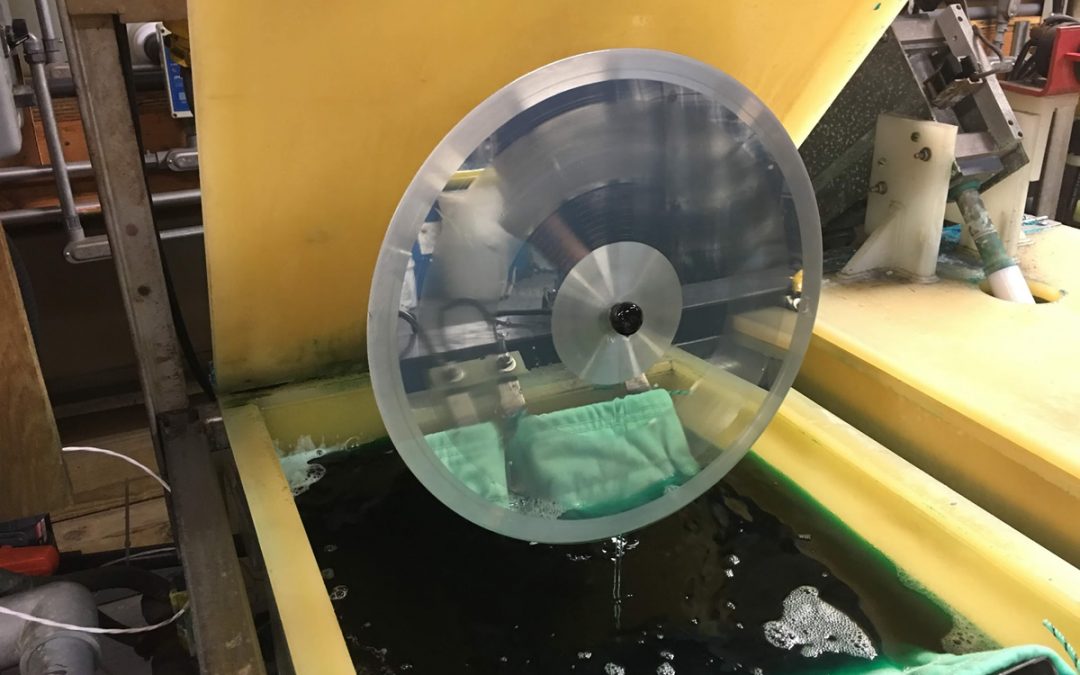Shown above is a lacquer disk being bathed in a nickel electroplating solution at Mastercraft Stampers, in Elizabeth, NJ.
An interesting aspect of precision electroforming in 2020 is that the same technology used to create microscopic elements used in space telescopes, microprocessors, and a host of cutting-edge nano technologies is also a critical component in the making of vinyl records, an end-product dating back to the early days of the last century.
While the market for music on vinyl is most assuredly a niche one, it is presently quite active and growing. Recently, vinyl record sales exceeded CD sales for the first time, reaching a 25-year sales high. Streaming music delivered a death blow to the CD business in the mid-2000s, but vinyl recordings have found a growing customer base among nostalgic baby boomers and 20-somethings discovering a “new” way to enjoy music. Novelty plus crisp, expansive sound quality (compared with standard MP3), and collectability are all part of vinyl’s appeal to a younger audience.
Most record buyers are probably not aware of the complex and costly manufacturing process behind the artwork-covered 12-inch disks that they’re paying up to $40 a piece for. In the hey-day of LPs (“long playing” records) from the 1950s through the 1970s, major music “labels” not only signed and managed the musicians, but also manufactured and distributed their work on millions of vinyl disks.
Today, vinyl production is mostly handled by smaller regional companies that may only provide one or two of the processing activities required for the complex alchemy that is vinyl record-making. While a few big record labels remain, they are for the most part out of the physical manufacturing business, and they rely on outsourcing production to these plating and pressing shops. Many independent artists and small producers also use these shops to format their work onto vinyl so they can offer their fans collectible merchandise at concerts that helps them gather more fans who may catch their music in this format.
The job of actually “printing” out the final product that will be packaged for retail distribution goes to a record pressing facility that uses specialized equipment that takes two metallized master stamper disks, the A and B sides of the record, to imprint the ridges and grooves of the sound waves onto a soft vinyl disk sandwiched in-between them. Each double-sided disk is dried and mechanically trimmed to size before being packaged for distribution. This process is then repeated, in assembly line fashion, to press the desired quantity of finished albums – a single master stamper disk can be used to produce thousands of them.
But creating the metal master stamper itself is a much more complex process, requiring multiple preparation steps that lead to “growing” the stamper in an electroforming bath. This plating step is often performed away from the pressing plant, due to its resource and operational requirements. Plating equipment and facility set-ups are costly, and specific expertise is called for. For all of these reasons, production times can be frustratingly long
Nonetheless, with the somewhat surprising growth in demand for vinyl, Digital Matrix is seeing an uptick for new plating equipment purchases from existing companies as well as serious inquiries from start-up players looking to “grow” (pun intended) vinyl production to serve their regional music communities.
For more information about the process of electroforming related to vinyl record production, contact Digital Matrix – we’re happy to help!

